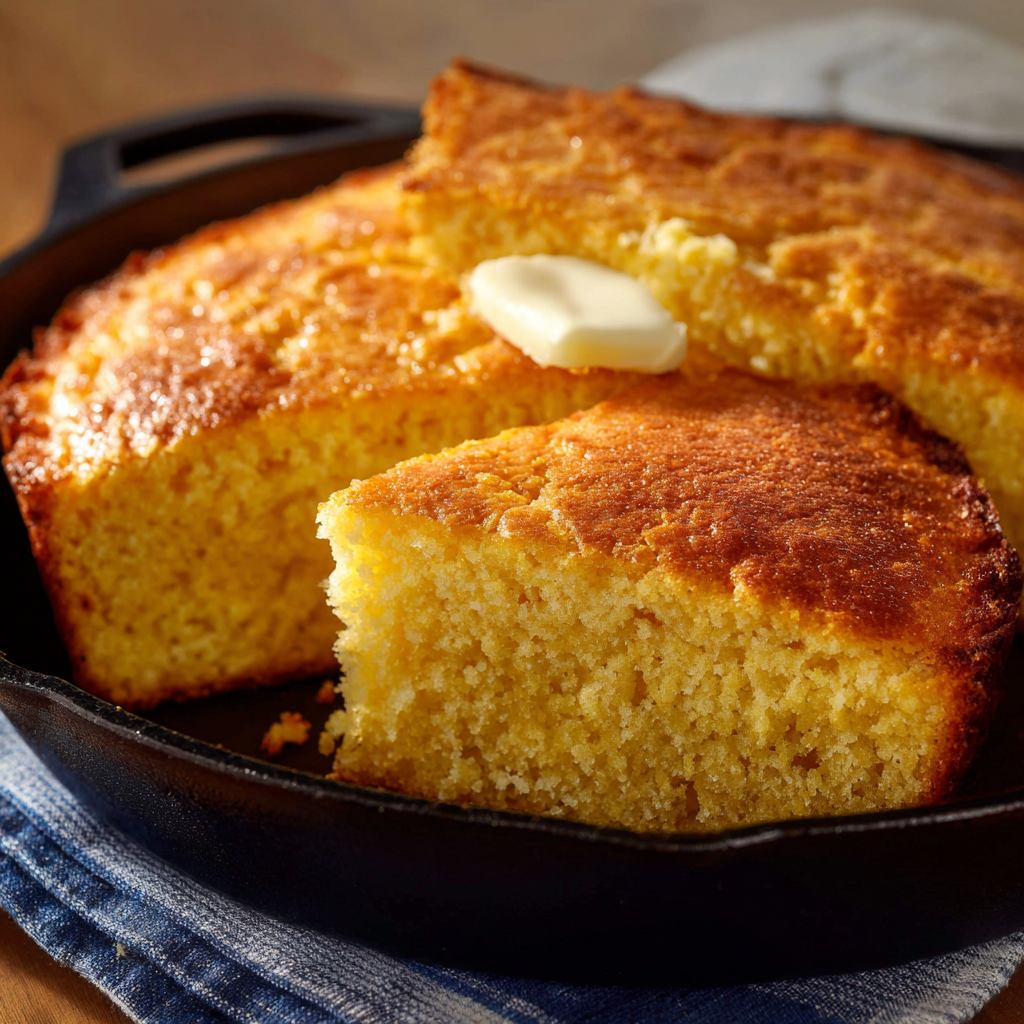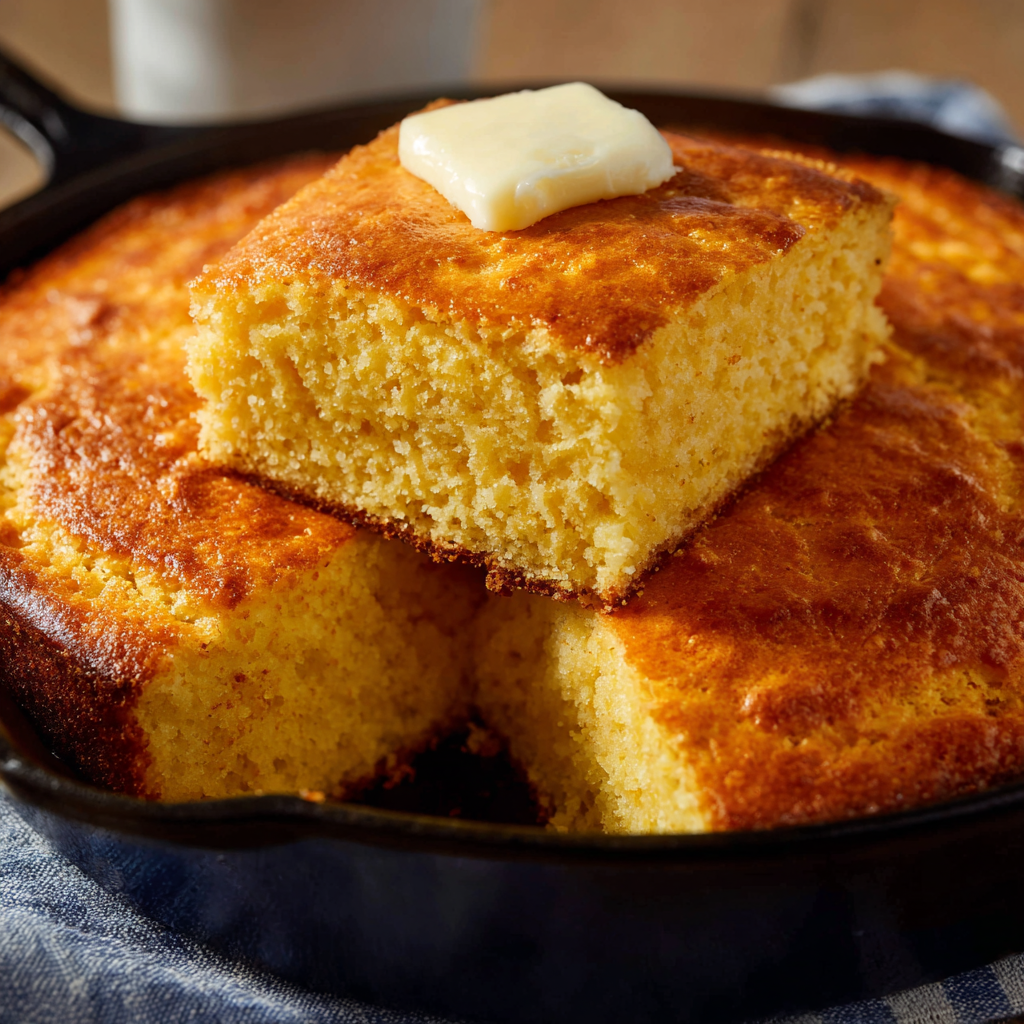 Pin it
Pin it
This old-fashioned buttermilk cornbread recipe brings that nostalgic taste of golden crisp edges and tender crumb to the table. The moment you pull it from the oven you know it is something special—a recipe handed down through generations that never fails to bring comfort to any meal.
Whenever I make this the smell takes me right back to my grandmother’s kitchen. Cornbread was our ritual beside every pot of stew or big weekend breakfast.
Ingredients
- Butter: gives richness and keeps the crumb soft. Use real butter for the best old-fashioned flavor
- White sugar: creates a gentle sweetness and helps the crust caramelize. Look for fresh sugar with no lumps
- Large eggs: add structure and moisture. Use eggs at room temperature for best blending
- Buttermilk: brings tang and keeps the bread tender. Whole buttermilk is best but low fat works too
- Baking soda: reacts with the buttermilk for the perfect rise. Always check that your baking soda is fresh
- Cornmeal: offers the signature flavor and texture. Stone-ground yellow cornmeal has the most old-fashioned taste
- All-purpose flour: keeps the bread light and soft
- Salt: balances sweetness and enhances overall flavor. Use fine salt so it blends evenly
Instructions
- Preheat the Oven:
- Set your oven to 375 degrees F so it is fully preheated by the time you are ready to bake. Grease an 8-inch square pan thoroughly making sure you get into the corners and up the sides so the bread releases cleanly.
- Melt the Butter and Mix in Sugar:
- Place butter in a large skillet over medium heat. Let it melt completely without browning then remove from the heat. Immediately add the sugar and stir vigorously until the mixture looks glossy and smooth and all the sugar is moistened.
- Add the Eggs:
- Quickly whisk the eggs into the warm butter sugar mixture one at a time. Make sure to whisk fast so the eggs do not cook or scramble from the residual heat. The mix should look creamy and well-blended here.
- Mix Buttermilk and Baking Soda:
- In a small bowl add the buttermilk first and then whisk in the baking soda. You should see the mixture foam up a little as the reaction starts getting your bread ready to rise perfectly.
- Combine Wet and Dry Ingredients:
- Pour the buttermilk and baking soda mixture into your skillet. Stir well to fully combine everything. Add cornmeal flour and salt directly to the skillet and stir gently using a spatula or wooden spoon. Mix just until there are no big dry pockets and only a few small lumps remain. Take care not to overmix otherwise the bread can turn out tough.
- Bake:
- Pour the batter evenly into your greased 8-inch square pan. Spread it out so the top is level. Place in the preheated oven and bake for 30 to 40 minutes. Start checking at the 30-minute mark—a toothpick inserted in the center should come out clean or with just one or two moist crumbs attached. The top will be golden and the edges set and pulling just slightly from the pan.
- Cool and Serve:
- Remove from the oven and let cool slightly before slicing for the best texture and clean slices.
 Pin it
Pin it
When I ate this as a child at my grandma’s table there was always a pat of melting butter on top for my first slice. Today I still reach for that real creamy butter and it brings back those kitchen memories every time.
Storage Tips
Once cooled cut cornbread into squares and store in an airtight container. It keeps well at room temperature for up to two days or in the fridge for five days. If you want to freeze leftovers wrap pieces individually and thaw before enjoying. A quick zap in the microwave restores its softness.
Ingredient Substitutions
If you run out of buttermilk use one cup of regular milk mixed with one tablespoon of lemon juice or vinegar. Let it sit for five minutes and use as directed. For a less sweet version reduce the sugar to one third cup or for added flavor try adding a pinch of smoked paprika or grated cheese.
Serving Suggestions
Serve warm with soup stew or chili for classic comfort. I love it alongside spicy beans or piled high with a drizzle of honey for breakfast. Cornbread also makes a fantastic base for Southern-style dressing or stuffing at the holidays.
Cultural History
Cornbread is woven into the story of Southern American cooking but its roots trace to Native American traditions using maize. Each family seems to have small tweaks—this recipe always stuck with ours because of its tender crumb and the gentle tang of buttermilk.
 Pin it
Pin it
This cornbread tastes just as good the next day and makes every meal feel special. I hope it brings comfort and good memories to your table too.
Frequently Asked Questions
- → How does buttermilk affect cornbread texture?
Buttermilk adds moisture and tang that helps create a tender, fluffy crumb with a pleasant slight acidity.
- → Why use both cornmeal and flour?
Combining cornmeal and flour balances texture, giving structure and softness while retaining classic corn flavor.
- → Can white sugar be substituted?
Yes, you can use honey or maple syrup for a different sweetness, but results may vary in moisture and taste.
- → What is the purpose of baking soda?
Baking soda reacts with buttermilk acidity to help the cornbread rise, making it light and airy.
- → How do you know when cornbread is done baking?
The cornbread is ready when a toothpick inserted in the center comes out clean or with just a few crumbs.
- → Can this be made in advance?
Yes, it keeps well. Reheat gently or serve at room temperature for best flavor and texture.
